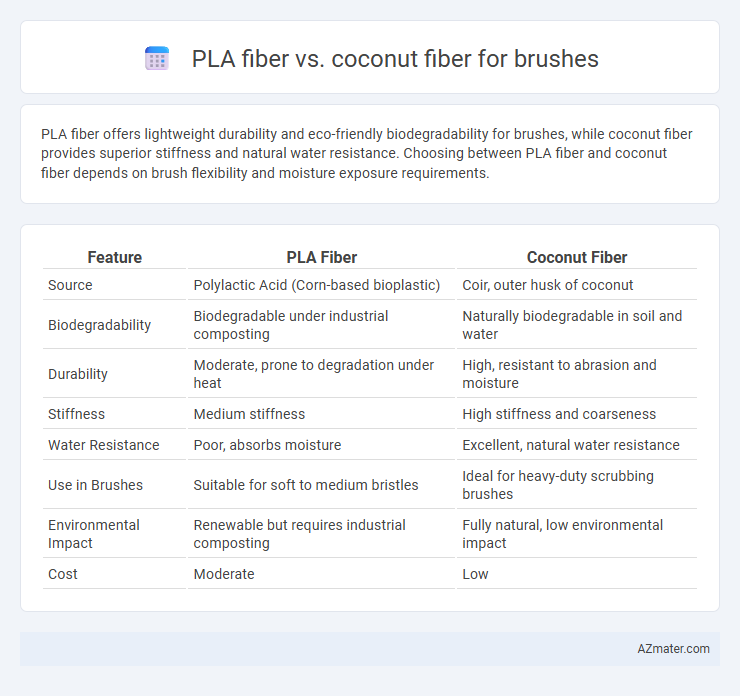PLA fiber offers lightweight durability and eco-friendly biodegradability for brushes, while coconut fiber provides superior stiffness and natural water resistance. Choosing between PLA fiber and coconut fiber depends on brush flexibility and moisture exposure requirements.
Table of Comparison
| Feature | PLA Fiber | Coconut Fiber |
|---|---|---|
| Source | Polylactic Acid (Corn-based bioplastic) | Coir, outer husk of coconut |
| Biodegradability | Biodegradable under industrial composting | Naturally biodegradable in soil and water |
| Durability | Moderate, prone to degradation under heat | High, resistant to abrasion and moisture |
| Stiffness | Medium stiffness | High stiffness and coarseness |
| Water Resistance | Poor, absorbs moisture | Excellent, natural water resistance |
| Use in Brushes | Suitable for soft to medium bristles | Ideal for heavy-duty scrubbing brushes |
| Environmental Impact | Renewable but requires industrial composting | Fully natural, low environmental impact |
| Cost | Moderate | Low |
Introduction to PLA Fiber and Coconut Fiber
PLA fiber, derived from polylactic acid, is a biodegradable, plant-based material known for its smooth texture and environmental friendliness, making it suitable for brushes requiring softness and durability. Coconut fiber, or coir, is a natural, coarse fiber extracted from coconut husks, valued for its stiffness and water resistance, ideal for heavy-duty scrubbing brushes. Both fibers offer sustainable alternatives to synthetic materials but serve different functional purposes based on their texture and strength.
Origin and Production Processes
PLA fiber, derived from fermented plant starch such as corn or sugarcane, undergoes a biotechnological process involving polymerization to create a compostable and biodegradable material ideal for sustainable brushes. Coconut fiber, sourced directly from the coarse outer husk of coconuts, is extracted through a mechanical process called decortication that separates the fibrous material from the shell. The production of PLA fiber emphasizes renewable agricultural crops and industrial processing, whereas coconut fiber relies on natural husk harvesting and manual or semi-mechanical extraction methods.
Physical and Mechanical Properties Comparison
PLA fiber exhibits higher tensile strength and elongation at break compared to coconut fiber, making it more durable and flexible for brush bristles. Coconut fiber is more rigid with superior abrasion resistance and natural water repellency, ideal for heavy-duty scrubbing tasks. The lower density of PLA fiber also contributes to lighter brush construction, while coconut fiber's coarse texture enhances cleaning effectiveness on rough surfaces.
Biodegradability and Environmental Impact
PLA fiber, derived from renewable resources like corn starch, offers complete biodegradability under industrial composting conditions, breaking down into water and carbon dioxide without leaving harmful residues. Coconut fiber, a natural coir obtained from coconut husks, biodegrades efficiently in soil environments and contributes to reduced landfill waste due to its organic composition. Both fibers provide eco-friendly alternatives for brush production, but coconut fiber's natural durability and minimal processing lend it a lower environmental footprint compared to the energy-intensive production of PLA fiber.
Performance in Brush Applications
PLA fiber offers high tensile strength and excellent flexibility, making it ideal for precision brush applications requiring durability and wear resistance. Coconut fiber, known for its coarse texture and natural abrasiveness, provides superior scrubbing ability and is effective in heavy-duty cleaning brushes. While PLA fibers enhance longevity and maintain brush shape over time, coconut fibers excel in abrasive performance for tough cleaning tasks.
Cost Analysis and Market Availability
PLA fiber, derived from renewable resources like corn starch, typically incurs higher production costs compared to coconut fiber due to complex manufacturing processes and limited large-scale suppliers. Coconut fiber, or coir, benefits from abundant availability in tropical regions, resulting in lower raw material costs and widespread market presence for brush manufacturing. Cost analysis reveals coconut fiber as the economical choice with consistent supply chains, whereas PLA fiber commands premium pricing linked to biopolymer technology and growing but niche market demand.
Sustainability and Renewable Resources
PLA fiber, derived from renewable cornstarch, offers a biodegradable alternative with a lower carbon footprint compared to petroleum-based materials, making it a highly sustainable option for brushes. Coconut fiber, sourced from natural coir husks, is an eco-friendly, biodegradable material that efficiently repurposes agricultural waste, enhancing circular economy benefits. Both fibers support renewable resource utilization, but coconut fiber's natural durability and waste reduction give it a unique advantage in sustainable brush production.
Maintenance and Durability in Use
PLA fiber brushes offer moderate durability with easier maintenance due to their resistance to mold and quick-drying properties, making them suitable for close-contact and indoor cleaning tasks. Coconut fiber brushes exhibit superior durability with natural toughness and high resistance to wear, moisture, and bacterial growth, enabling long-lasting use in heavy-duty or outdoor applications. Both fibers require regular cleaning to maintain performance, but coconut fibers generally endure more rigorous conditions with less frequent replacement.
Consumer Preferences and Trends
Consumers increasingly prefer PLA fiber brushes for their biodegradability and smooth texture, which provides a comfortable grip and efficient cleaning. Coconut fiber brushes attract eco-conscious buyers due to their natural durability and resistance to water, aligning with sustainable lifestyle trends. Market data shows a rise in demand for plant-based fibers, with PLA gaining traction in urban areas and coconut fiber favored in rural and tropical regions.
Future Prospects and Innovations
PLA fiber exhibits strong potential as a sustainable alternative to coconut fiber for brush manufacturing due to its biodegradability and ability to be engineered for enhanced durability and flexibility. Innovations in bio-based polymer blending and nanocomposite technology are driving PLA fibers towards improved performance, enabling their use in high-quality, eco-friendly brushes. Future prospects include integrating antimicrobial properties and optimizing PLA fiber production to reduce environmental impact while meeting growing consumer demand for sustainable personal care products.

Infographic: PLA fiber vs Coconut fiber for Brush
 azmater.com
azmater.com